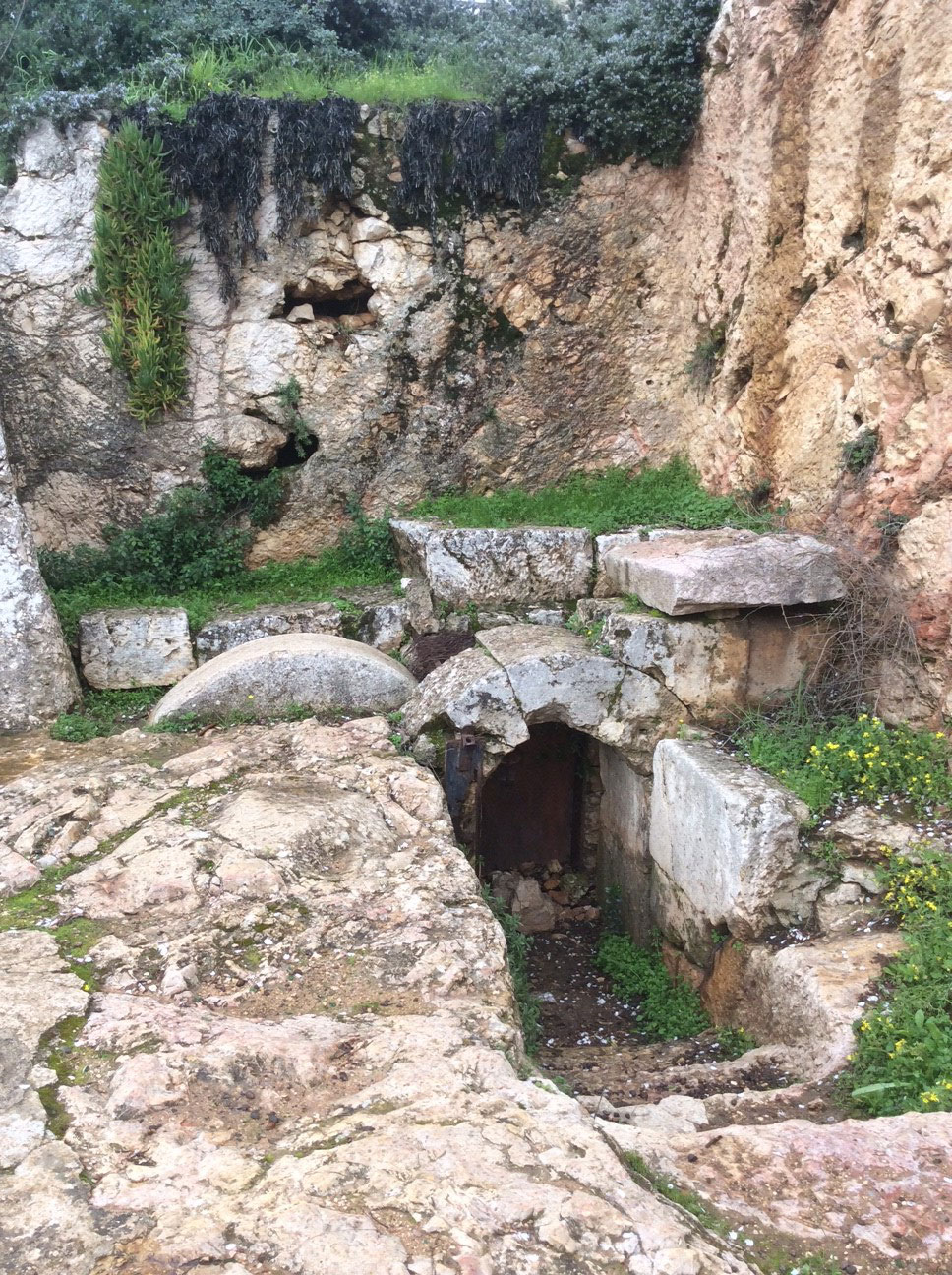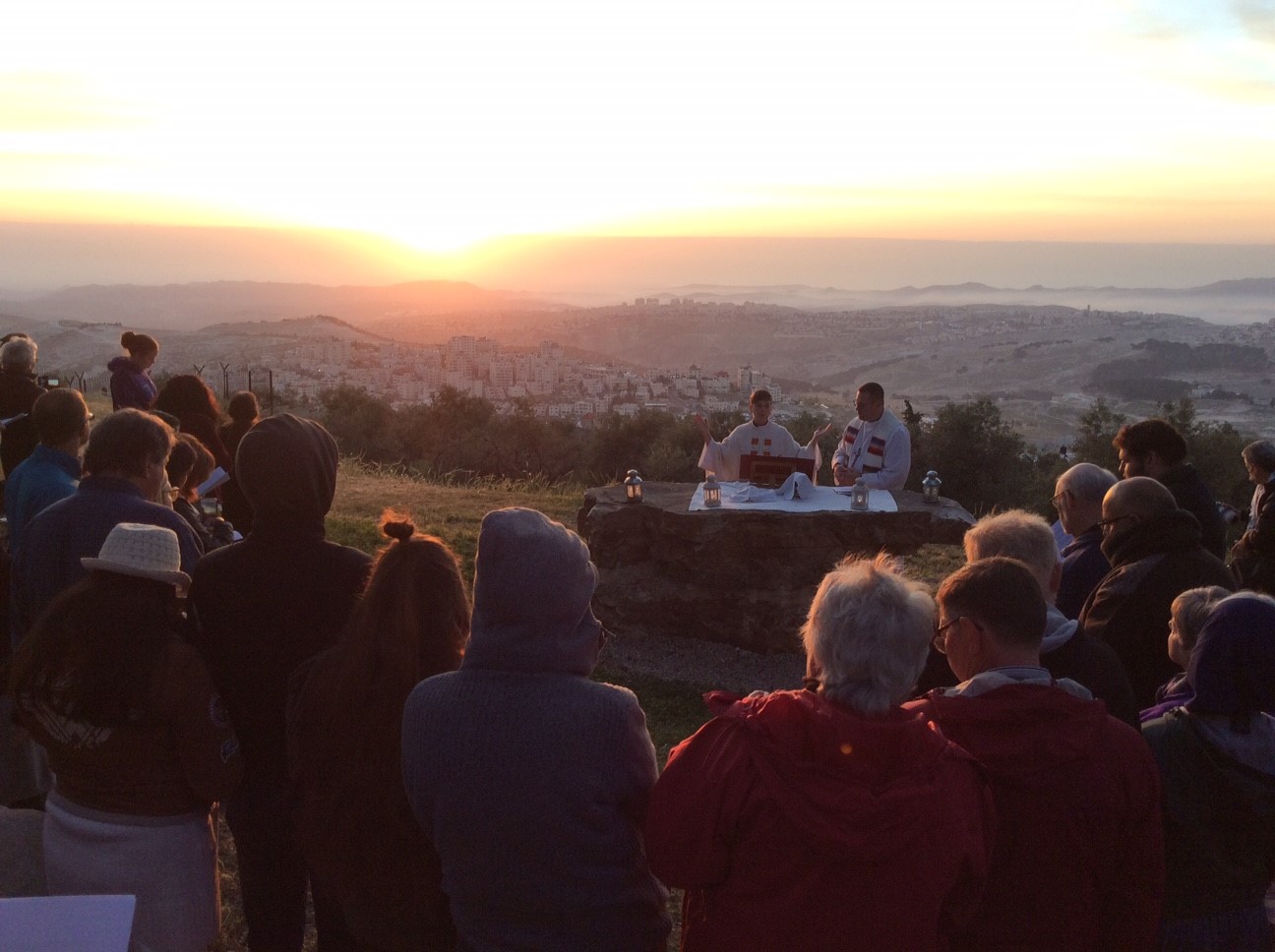A Letter from Doug Dicks, serving in Israel and Palestine
May 2018
Write to Doug Dicks
Individuals: Give online to E200516 for Doug Dicks’ sending and support
Congregations: Give to D506222 for Doug Dicks’ sending and support
Churches are asked to send donations through your congregation’s normal receiving site (this is usually your presbytery)
Dear Friends and Relations,
Hello and greetings from Jerusalem! It is the season of Pentecost, and we have just ended the period of Lent, leading up to Holy Week and Easter here in the Holy Land.
At the Garden Tomb here in Jerusalem, a wooden door stands closed at the entrance to the tomb when special Sunday services are held.
Hanging on the wooden door is a plaque that reads, “He is not here; For He is Risen.” The closed door is almost an affront to any visitor, and seems to be saying, “Go away!” And like the angels, who perhaps gently chastised those first Easter morning visitors to the tomb, it seems to be saying to anyone approaching that door, “why are you looking for the living amongst the dead?”
For Christians who believe in the birth, life, ministry, passion and the resurrection of Jesus Christ here on earth, the resurrection of Jesus Christ is the linchpin of our faith. This is where hope was reborn. This is where history was made. This is where the world as humankind knew it was turned on its heels! This is where the ultimate victory of life over death was won. It is here we take courage, and here that hope is renewed.
Yet every year, tens of thousands of Christian visitors and pilgrims worldwide make the journey to Jerusalem, and many come to the Garden Tomb, to see for themselves if the tomb is indeed really empty.
I sometimes duck into the side street and make my own way towards the garden. The space is a respite from the noise and chaos of the city around it. I enjoy seeing the trees and flowers in blossom in the various seasons of the year, and I rest in the quietness — save for those thousands of tourists who have also come to this place.
More often than not, I stop in the gift shop on the way out. After all, and most likely not by chance, the only way out just happens to be an exit that requires one to pass through the gift shop! Here, I oftentimes purchase bookmarks or cards to send to relatives and friends back home. As I pass through the shop, I catch a glimpse of the tomb down below. Here, on any given day, hundreds if not thousands of people pass, stop, look in, step in, and view the empty tomb. I often joke that they are just “dying” to get in!
When I once watched a visiting group crowd into the small space known as the antechamber of the tomb, I chuckled to myself. One by one they emerged, as if “risen” or “resurrected,” while someone snapped their photos.
This place was identified in the late 1800’s by a British general known as Gordon. Not far away, attached to — but not owned by — the entire garden complex, is an area known as “Gordon’s Calvary,” a rocky outcrop that at one time resembled a skull in stone. Today, however, it appears that the “cartilage” of the nose has weathered away. Still, if one looks at the rocky outcrop from a certain angle, one can see what looks like the appearance of a skull. On top of the rock, stretching across the surface, is a Muslim cemetery, just above the Palestinian bus station in East Jerusalem.
In what is today called the “Old City” of Jerusalem, referring to the walled city, stands the Church of the Holy Sepulchre. It is regarded by most Eastern Christians, as well as by Christians of other faith traditions, as the more authentic location of the garden and tomb. Somewhat chaotic and confusing, it too receives hundreds of thousands of Christian pilgrims and tourists every year.
The site was identified by Queen Helena, the mother of the Roman Emperor Constantine in the Byzantine period, and here she had a church built over the razed ruins of a temple built to the Roman goddess Venus. Later, it is said, she discovered what would be called the “True Cross.” Today, in the lower depths of the church, within the Armenian section, one can find a statue of Queen Helena, an area believed to be the place where she unearthed three wooden crosses.
In late February of this year, facing a proposed bill by the Israeli Knesset that would tax church properties, the Heads of Churches of Jerusalem made an unprecedented decision to close the doors of the Holy Sepulchre Church. Greek Orthodox, Armenian Apostolic and Catholic leaders, who jointly manage the holy site in Jerusalem’s Old City, complained of plans by the city’s municipality to modify a religious tax exemption that they said was “an attempt to weaken the Christian presence in Jerusalem.” According to the church leaders, should this new piece of Israeli legislation be passed, it would allow the Israeli government to confiscate land sold by the church.
Recognizing that the closure of the church could potentially be reason enough for thousands of tourists and pilgrims to begin cancelling their planned travels to Jerusalem, the Israeli Knesset agreed to table the proposed bill indefinitely. Standing firm, the churches reopened the doors to this sacred site once again, only two days after having closed them. As if the mere reopening of the doors of this ancient and holy edifice were not enough reason to feel a sense of relief, I felt compelled like many others to go and see for myself. It was almost as if a resurrection had occurred, all over again! And it was unprecedented that the doors of the church should have been closed indefinitely in the first place. Had the controversial “tax bill” been passed, it would have violated the status quo, which governs the communal arrangement of religious matters relative to the holy places. A small yet significant non-violent act of religious solidarity that served its purpose well.
So, which of the two places is THE place? Where is the actual tomb? Is it the Garden Tomb, which resembles the biblical setting we read about, and perhaps appears more to our liking? Or is it the confusing and often chaotic Church of the Holy Sepulchre, with its strange and unusual nooks, crannies and spaces that resemble those of countless other aging edifices throughout the world?
From an archaeological perspective, most likely it is the Church of the Holy Sepulchre. At one time, the entire area and space under and around where the structure was built was a stone quarry, and it did indeed exist outside of the walls of the city of Jerusalem at the time of the crucifixion.
However, for us as Christians, the place should not be important. For no matter where the tomb is, or was, we know it is empty.
Some of Jesus’ final words were to a repentant thief, also dying on a cross. “Today you will be with me in paradise.”
If Christ promised a repentant thief a new life in his eternal kingdom, how much more so are we — who have lived in the faith all our lives and believe in the death, resurrection, and promises of Jesus Christ — to receive eternal life in a paradise promised us?
Take heart, dear friends. Christ lives! Alleluia!
And if Christ is for us, who can be against us?
May the joy of Christ, Risen, give you comfort, courage and strength all the days of your lives.
Alleluia! Amen!
Thanks to each of you who so graciously supports my work here in the Holy Land. Without your financial gifts, my presence and my work here would not be possible. Each and every one of them is most appreciated.
Blessings,
Doug
![]() You may freely reuse and distribute this article in its entirety for non-commercial purposes in any medium. Please include author attribution, photography credits, and a link to the original article. This work is licensed under a Creative Commons Attribution-NonCommercial-NoDeratives 4.0 International License.
You may freely reuse and distribute this article in its entirety for non-commercial purposes in any medium. Please include author attribution, photography credits, and a link to the original article. This work is licensed under a Creative Commons Attribution-NonCommercial-NoDeratives 4.0 International License.
Tags: courage, easter, Garden Tomb, General Cordon, Gordon's Calvary, Holy Sepulchre, Holy Week, hope, journey, Knesset, lent, Pentecost, religious solidarity, tax bill, tourism, True Cross
Tags: Doug Dicks









